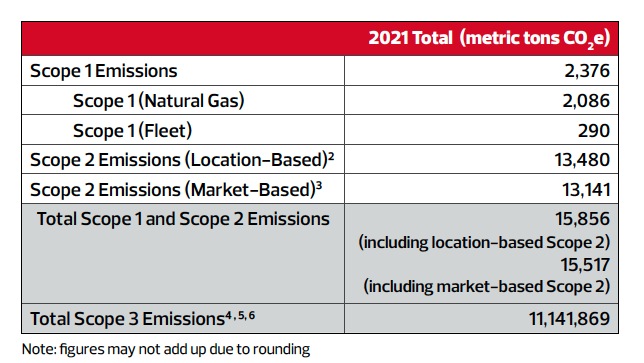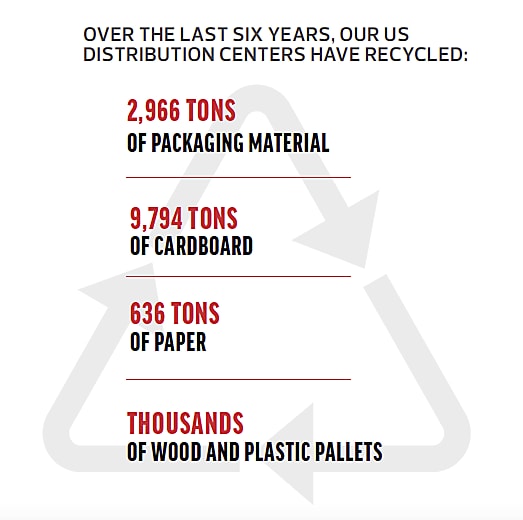ENVIRONMENTAL: Protecting the World We Share
CDW is committed to protecting the environment by continuing to find ways to manage our business with increasing efficiency and understanding the full extent of our environmental impact.
Our efforts include participating in multiple electronics recycling programs, consistently meeting and exceeding our waste diversion goal of 90% at our US distribution centers, and implementing smart packaging solutions that maximize both product protection and material efficiencies.
While we strive for continuous improvement in the environmental performance of our own operations, we recognize that our greatest opportunities to impact the environment lie in our supply chain and our ability to work with our partners to address issues such as climate change and waste reduction. For example, more than 75% of our US shipments are handled by carriers with Net Zero emissions targets.
Learn more starting on page 20 of our 2021 ESG report.
What's New
- Case Study: Empower Month: Supporting Our Communities
- Case Study: CDW’s ESG Strength Reflected in Recent Ranking

Energy Management
We track our energy management performance on an ongoing basis and continue to seek ways to drive further efficiencies. As part of our ISO 14001 certification, we maintain a three- to five-year window of visibility to identify, assess and plan for implementation of additional energy efficiency improvements.
Specific energy efficiency efforts include:
- Energy-efficient lighting solutions, including indoor and outdoor LED lighting
- Motion sensor lighting and conveyor systems that turn off in response to inactivity
- ”Smart” HVAC systems that adjust according to business hours and seasonal temperatures
- Water consumption solutions, including rainwater harvesting efforts in the UK and environmentally friendly water heaters in the US.

Our New Chicago Office Building
Climate Action
As part of our ongoing commitment to understanding and disclosing our environmental impact, we engaged with third-party environmental consulting firms to assess our Scopes 1, 2, and 3 emissions and identified climate action opportunities for CDW. The table [to the right] summarizes our greenhouse gas emissions in 2021.
Given the non-manufacturing nature of our operations, our facilities do not represent a significant climate footprint. However, working with our third-party shipping and logistics partners presents an opportunity for us to focus on carbon emission reductions in our value chain.
Approximately 98% of our US shipments are delivered by carriers enrolled in the U.S. EPA SmartWay Transport Partnership, which helps companies advance supply chain sustainability by measuring, benchmarking and improving freight transportation efficiency. Furthermore, more than 75% of our US shipments are handled by carriers with Carbon Neutral or Net Zero emissions goals.


1 The emissions of Sirius Computer Solutions are not included in the emissions totals. The acquisition of Sirius was reported in October 2021 (10/19/2021) and completed in December 2021 (12/02/2021).
2 A location-based method reflects the average emissions intensity of grids on which energy consumption occurs. Calculated using the 2021 US EPA eGRID emission factors for US-based locations and the 2021 IEA Country Emission Factors for international locations with active energy consumption data. Where consumption data was not available, CDW utilized the 2012 Commercial Building Energy and Consumption Survey (CBECS) to estimate location consumption using average emission factor values that are based on location and size of each site location.
3 A market-based method reflects emissions from electricity that companies have purposefully chosen. Calculated using an emission factor of zero for all applicable sites which procured verified Renewable Energy Certificates equal to the corresponding amount of energy consumed at each site.
4 CDW follows the Greenhouse Gas Protocol Technical Guidance for Calculating Scope 3 Emissions (version 1.0) and Corporate Accounting and Reporting Standard. Scope 3 emissions are calculated using the operational control approach.
5 Includes emissions from CDW’s US and Canada value chains for calendar year 2021 (January 1, 2021, through December 31, 2021).
6 Emissions were evaluated across 19 categories of CDW’s purchased products, which included direct and indirect procurement. Emissions were calculated by determining the amount spent per category and multiplying by spend-based emissions factors from US Monetary EPA and ADEME.
Materials and Materials Efficiency
We seek to reduce waste to landfill through enterprise-wide recycling initiatives, implementing innovative packaging solutions and integrating principles of environmental responsibility throughout our business.
Our recycling efforts include:
- Elimination of plastic bottles from vending machines in our offices and warehouses
- Elimination of single-use plastic cups
- Company-wide internal toner cartridge recycling program
- Recycling centers on each floor of our office locations
- Recycling chutes for certain materials at our distribution centers
- Collaboration across procurement functions to reduce the need for consumable supplies and increase recycling possibilities across our offices

To ensure proper disposal of electronic waste, our IT Asset Disposition Services (ITAD) teams offer our customers proper device wiping, removal, evaluation and recycling services for devices that are no longer being used. Proper asset disposition involves completely and securely wiping devices of sensitive data and environmentally responsible recycling and disposal of e-waste. For any devices of value, we provide a buyback rebate on our customer’s CDW account. For more information, see this What’s New story.
At our distribution centers, we utilize a number of packaging processes that address environmental considerations, while still meeting and exceeding customer expectations. For the third year in a row in 2021, CDW’s US distribution centers outperformed their waste diversion goal of 90%+.
Our solutions include:
- Using and reusing our vendor partners’ packaging when possible, minimizing the need for additional packaging materials when fulfilling customer orders
- Redesigning our cartonization process to utilize algorithms that consider dimensional fit (a more accurate method than volume fit), which enables us to use the least amount of packaging possible
- Using envelope shippers that are 100% recyclable and provide warehouse and shipping space efficiencies for small items
Additionally, our pick-pack shipping containers are made from the maximum allowable amount of post-consumer recycled material and are 100% recyclable. We continue to work with our vendor partners and logistics suppliers to evaluate opportunities for smarter packaging solutions that maximize both product protection and material efficiencies.



